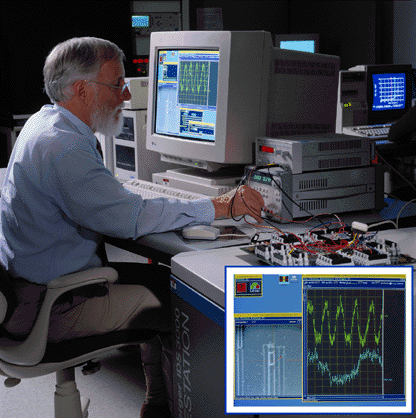SAN JOSE, Calif., November 30, 1998 – A unique co-development model
in place between the UMC Group and Xilinx, Inc., (NASDAQ:XLNX), has led
to the production of the first field programmable gate arrays (FPGAs) capable
of operating at speeds of one gigahertz (see picture below).
The prototype FPGAs, derivatives of the XC4036XV family, were part of a
mask set co-developed by the two companies to be used as the process driver
for the new 0.18 micron technology.
The aggressive development of the 0.18 micron process, currently among
the most advanced in the world, reflects the very close working relationship
between UMC Group and Xilinx. The partnership is based on an on-going,
mutual effort to be at the leading edge of semiconductor industry process
development. This unprecedented level of cooperation is allowing
FPGA users to have early access to the most advanced technology for low-power,
high performance applications.
“Xilinx is an ideal development partner because it is dedicated to being an early adopter of advanced foundry technology. Moreover, the regularity of the SRAM-based Xilinx FPGA architecture facilitates defect analysis and fault testing, making FPGAs excellent vehicles to troubleshoot the most up-to-date UMC Group processes,” said Jim Kupec, president of UMC Group (U.S.A.). “We also have been using the UMC Group Silicon ShuttleSM test-chip program as a vehicle for early verification of customer and IP vendor designs based on our 0.18 micron design rules. We have already run two 0.18 micron Shuttles and are currently accepting applications for the next one scheduled for tape-out on January 30.”
Xilinx recently benchmarked the performance of the prototype 0.18 micron devices using a frequency counter design and observed the FPGA operating at frequencies up to 1GHz. This level of performance will be required for emerging communications equipment such as OC-12 systems and DSP systems capable of handling more than 200 million samples per second.
“Our strategy is to provide maximum value to our customers by aggressively pushing FPGA technology to the limits in order to provide more advanced features and performance,” said Wim Roelandts, president and CEO of Xilinx. “Like Xilinx, UMC Group is clearly focused on being at the leading edge of process technology. This common objective has led to a highly successful partnership.”
“There’s no question that the technology gap that existed between the fabless/foundry model and integrated device manufacturers has been closed,” said Dennis Segers, vice president of FPGA development at Xilinx and general manager of the company's high end FPGA business unit. “Our co-development strategy with UMC Group has enabled us to develop complex FPGAs that act as process drivers for UMC Group foundries. Early engagement between engineering teams from both companies allows us to quickly diagnose product yield and performance problems that require corrective action in the fab. Xilinx and UMC Group back this up with R&D investments in tools and resources devoted to helping get the latest process to market faster. This helps Xilinx get its products deployed more quickly on the most advanced processes and ensures that we continually lead the competition in technology and performance.”
About UMC Group
UMC Group is a world leading semiconductor foundry and the first company
in Taiwan to offer foundry services. UMC Group is United Microelectronics
Corp. (UMC), United Semiconductor Corp. (USC), United Integrated Circuits
Corp. (UICC), United Silicon, Inc. (USIC) and UTEK Semiconductor Corp.
(UTEK). The group leads the dedicated foundry industry in value-added design
services and 0.25 micron capacity and yields. In 1999, UMC Group will have
production-ready 0.18 micron and copper interconnect technology.
The Silicon ShuttleSM test-chip program enables library vendors, IP vendors
and foundry customers to verify their designs in silicon at low or no charge.
UMC Group companies are headquartered in Taiwan, with marketing and customer support offices located in the United States, Japan, and the Netherlands. UMC Group (USA). Offices are located at 788 Palomar Avenue, Sunnyvale, CA 94086, tel. (408) 733-8881, fax (408) 733-8090.
About Xilinx
Xilinx is the leading innovator of complete programmable logic solutions,
including advanced integrated circuits, software design tools, predefined
system functions delivered as cores, and unparalleled field engineering
support. Founded in 1984 and headquartered in San Jose, Calif., Xilinx
invented the field programmable gate array (FPGA) and commands more than
half of the world market for these devices today. Xilinx solutions
enable customers to reduce significantly the time required to develop products
for the computer, peripheral, telecommunications, networking, industrial
control, instrumentation, high-reliability/military, and consumer markets.
For more information, visit the Xilinx web site at www.xilinx.com.
#9852
| Editorial contact: | |
| Mike Seither | Alex Hinnawi |
| Xilinx, Inc. | UMC Group |
| (408) 879-6557 | (408) 523-0903 |
| mike.seither@xilinx.com | alex.hinnawi@umc-usa.com |

An engineer uses an electron beam to test a prototype 0.18 micron Xilinx FPGA produced at a UMC Group foundry in Taiwan. The test measures the operation of an actual circuit programmed on the chip that uses commonly available logic and interconnect on the FPGA. A close up of the operator’s screen (inset, lower right) shows the waveform of the circuit repeating itself every billionth of a second at a frequency of 1 gigahertz.